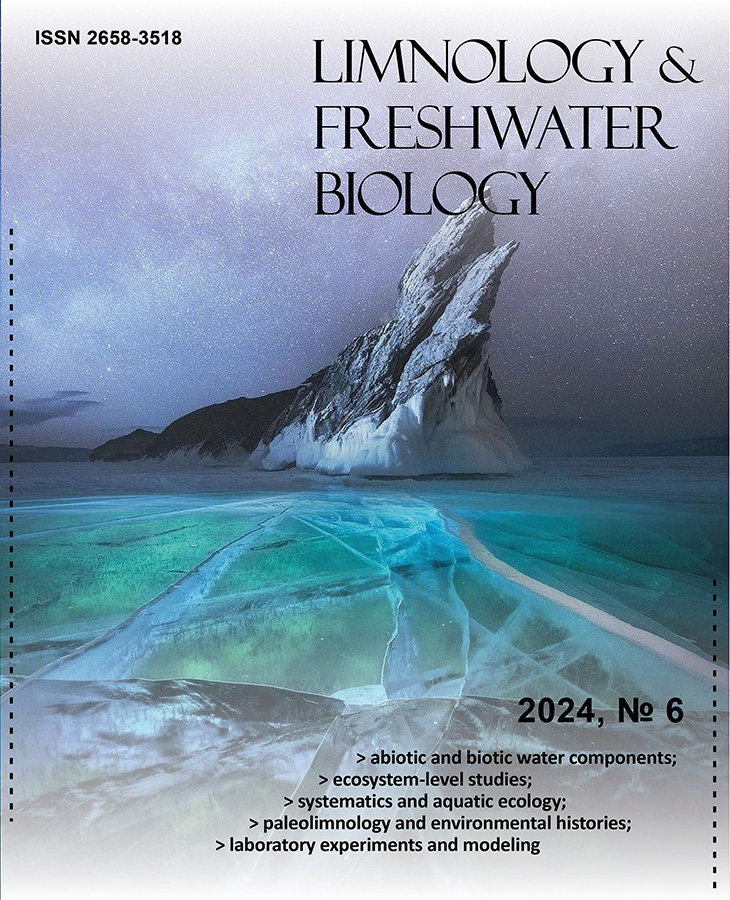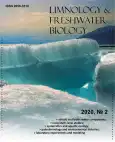No 2 (2020)
Articles
Morphological differentiation of the otoliths of graylings from the Barguzin River and Lake Baikal
Abstract
A comparative analysis of distinctive morphological features of sagittae in the Thymallus species from Lake Baikal and the Barguzin River has been done. The otolith shape was described using values of radii and the Fourier descriptors. It is demonstrated that the otoliths of Thymallus species have a similar structure. The otolith outline analysis allowed to differentiate the samplings according to the morphotypes that characterize them. No significant differences in length, width, perimeter and area of the otoliths in the Thymallus species have been identified. However, some differences in the shape of otoliths were described in T. baicalolenensis; they had a less developed pararostrum and more salient ventral edge than the otoliths of T. baicalensis from the lakes Balan-Tamur and Baikal. The otolith shape analysis can be widely applied for basic research of microevolutionary processes, delimitation of natural populations and preservation of genetic diversity as well as for defining the structure of the commercial stock.
 382-386
382-386


Study of absorption characteristics of phytoplankton, particles and colored dissolved organic matter in Lake Baikal (July 2018 and September 2019)
Abstract
Results of two scientific cruises carried out in July 2018 and September 2019 were used for an analysis of variability in spectral bio-optical properties of Lake Baikal. Chlorophyll a concentration, spectral light absorption coefficient of phytoplankton, non-algal particles and colored dissolved organic matter varied in ~order of magnitude between stations. Vertical distribution of these bio-optical parameters depended on water column stability in euphotic layer. The chlorophyll a profiles were characterized by maximum near the bottom of euphotic zone. In the layer of deep chlorophyll a maximum the phytoplankton absorption spectra had a specific feature – a local maximum at 550-570 nm. It was associated with relative increasing of phycoerythrin containing species in phytoplankton community. The absorption budget at 440 nm showed that the CDOM was the main optically active component, which provided ~ 50 % contribution to total absorption on averaged over Lake Baikal surface.
 387-390
387-390


Water quality in the littoral zone of the Barguzin and Chivyrkuy bays in the summer of 2019
Abstract
Currently, with an increase in technological progress, anthropogenic impact on the environment is increasingly apparent. Since surface waters are the most vulnerable part of the natural environment, a detailed study of water pollution is one of the urgent tasks. This article presents the results of the instrumental measurements and the assessment of the pollution of the surface waters in the littoral zone of the Barguzin and Chivyrkuy bays of Lake Baikal. To determine the degree of water pollution, we compared hydrochemical indicators with the standards of the maximum permissible concentrations. We revealed that in different parts of the Chivyrkuy Bay, water quality varies in a wide range from slightly polluted to very polluted and, in some cases, highly polluted. The waters in the Barguzin Bay can mainly be classified as slightly polluted, and only in some areas – as moderately polluted or highly polluted. According to the comprehensive water pollution index, the waters in the Chivyrkuy and Barguzin bays is assessed as conditionally polluted and conditionally pure, respectively.
 391-396
391-396


Assessment of water pollution near the deep oil seep in Lake Baikal
Abstract
Water purity was assessed at the site of a deep oil seepage near Cape Gorevoy Utes (Central Baikal). Polycyclic aromatic hydrocarbons (PAHs) and n-alkanes were determined in different types of oil-containing samples collected at this section of Lake Baikal. The set of studied samples included: (i) samples of water from the surface water layer; (ii) samples of water from different depths; (iii) oil on the water surface; (iv) oil from a sediment core. In the surface water layer and the water column, the total concentration of n-alkanes ranged from 0.2 to 5.3 µg/L and did not exceed the 0.1 maximum permissible concentration (MPCfish = 50 µg/L) established for hydrocarbons in water bodies of fishery importance. PAHs with carcinogenic properties were less than 0.1 ng/L. The total concentration of PAHs found in the water column did not exceed 110 ng/L; toxic equivalent (TEQ) values ranged from 0.001 to 0.110 ng/L. The distribution of petroleum hydrocarbons from the seepage site was limited, and water pollution was localised. The low level of water pollution is associated with natural mechanisms in the Baikal ecosystem. Microbiological community and phytoplankton make a decisive contribution to the purity of Baikal water, and oil fractionation during deep discharge contributes to the bioavailability of petroleum hydrocarbons.
 397-404
397-404


The phylogeny based on the intron of ATP synthase α-subunit gene reveals a substrate role in the origin of the gastropod species flock from Lake Baikal
Abstract
A nuclear marker, an intron of ATP synthase α-subunit gene, used to determine phylogenetic relationships between 22 species of the family Baicaliidae (Caenogastropoda: Rissooidea) indicated two genetic groups of these gastropods in Lake Baikal. The obtained groups partially coincide with the clusters revealed by the mitochondrial COI gene and do not fully coincide with the modern taxonomy of the family. Thirteen species of the first group inhabit different sediments (silty sand, sand, stones, and rocks), eight out of the nine species from the second group are psammobionts. Both genetic groups include eurybathic and stenobathic species widely distributed in the North, Middle and Southern Basins of the lake, as well as species, whose habitats are limited to one or two basins. Phylogenetic analysis suggests that the main way of baicaliids speciation was the repeated occupation of the same habitats by different ancestral forms. Sculpture of the shells (ribs, carina and/or periostracal hairs/plates) also most likely appeared independently in each group due to similar adaptation.
 405-411
405-411











